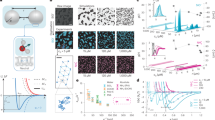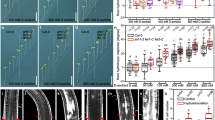Abstract
DURING an investigation into the effects of various anions on the precipitation of the paracrystalline solid phase of tobacco mosaic virus nucleoprotein (Marmor tabaci, var. vulgare, Holmes) from its solution in water, the salicylate ion was found to behave differently from other anions. For each salt there was found a critical concentration at and above which the virus was precipitated from solution in the form of spontaneously birefringent microtactoids or fibres. The white precipitate of virus nucleoprotein is still fully infective and may be redispersed to give a clear solution by mechanical agitation or dilution as described previously1. However, the precipitate produced by solutions of potassium salicylate at concentrations above 0.46M. is very different in character from that obtained with other salts. It consists of an insoluble, amorphous, white, granular solid deposit of denatured protein. Mechanical agitation or dilution does not cause re-solution. At the same time the virus loses its infectivity irreversibly. The accompanying graph illustrates the rate of inactivation of a 0.2 per cent solution of the pure virus by 1.0M. potassium salicylate at pH. 7 and 30° C. The straight line nature of curve Bindicates that the rate of inactivation is logarithmic. The rate of inactivation is greater the greater the concentration of salicylate and is markedly influenced by the temperature. With solutions of salicylate of the order of half molar there is only a partial inactivation, and a steady state appears to be set up after a few hours. At a concentration of 1.0M. there is no loss of infectivity, of stream double refraction or solubility after a contact of forty-eight hours. Denaturation, loss of stream double refraction and of infectivity all run parallel.
This is a preview of subscription content, access via your institution
Access options
Subscribe to this journal
Receive 51 print issues and online access
$199.00 per year
only $3.90 per issue
Buy this article
- Purchase on Springer Link
- Instant access to full article PDF
Prices may be subject to local taxes which are calculated during checkout
Similar content being viewed by others
References
Best, Rupert J., NATURE, 139, 628 (1937).
Anson, M. L., and Mirsky, A. E., J. Gen. Physiol., 17, 399 (1933).
Holden, H. F., Austral. J. Exp. Biol, 14, 291 (1936).
Author information
Authors and Affiliations
Rights and permissions
About this article
Cite this article
BEST, R. Some Effects of Salicylate on Plant Viruses. Nature 145, 627–628 (1940). https://doi.org/10.1038/145627b0
Issue Date:
DOI: https://doi.org/10.1038/145627b0
This article is cited by
-
A Biochemical Approach to Viruses
Nature (1950)
Comments
By submitting a comment you agree to abide by our Terms and Community Guidelines. If you find something abusive or that does not comply with our terms or guidelines please flag it as inappropriate.



